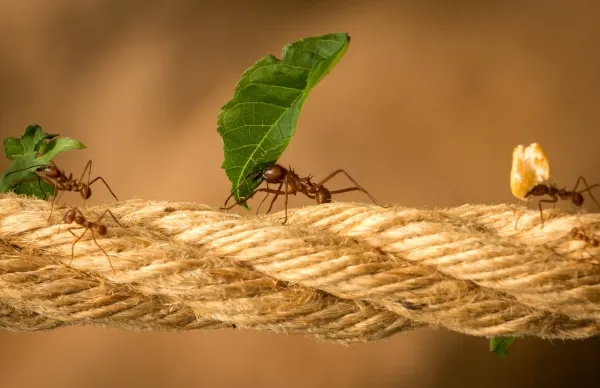How long do worker ants live?
How long do ants live?
Ants belong to the class of insects and are grouped within the Formicidae family. It is a very diverse group, since there are more than 10,000 species, although it is estimated that this figure could be considerably higher. The ants are distributed globally, with the exception of certain islands and Antarctica. One of its most outstanding characteristics is its complex social habits, since they are structured in different hierarchical levels and organized according to the functions they perform for the colony. On the other hand, they have a complex communication system, which can be visual, olfactory or tactile.

How long do queen ants live?
Ants are characterized by having a high and complex social system, which implies, among other things, a structure divided into castes, which correspond to:
- Worker ants: sterile females that fulfill various roles.
- Fertile males: known as drones.
- Queen ants: they are fertile females with the reproductive function within the colony.
All castes are indispensable within the colony. In the case of queens, they have the responsibility of producing all the offspring that are part of it, as well as other queens, workers and drones. This reproductive process also allows the formation of other colonies, since the new queens, when the time comes, will leave their native colony and form their own.
Now, how long does a queen ant live? Queen ants live for around 20 years , although cases of up to 30 years of life have been reported in captivity. Thus, they are very long-lived animals, although as always in nature there may be exceptions.
Why do queen ants live so long?
How is it possible that apparently fragile animals can live so many years? One aspect that can influence queen ants to live so many years, despite being vulnerable animals, is that, once they found a colony, they always remain within it. In this way, if the nest is not affected by a predator or an environmental event, the queen ant is not exposed to danger because it is completely sheltered. In addition, the queen is the largest caste, which gives her some resistance.
How long do worker ants live?
Unlike queens, worker ants have a significantly shorter lifespan, which is generally between 1 and 3 years approximately. What is the reason for this big difference? Let’s see.
We have mentioned that the queens never leave the nest, however, the workers fulfill different roles such as the following:
- Take care of the new ants while they are in the different phases.
- Go out to look for food.
- Defend the colony from intruders.
For all these reasons, the workers are exposed to various dangers every time they leave the colony. To this is added that they are smaller individuals and, although in a group they can exert significant force, individually they are much more fragile.
How long do drones live?
The male ants or drones are the ones that live the least within the different castes that we have seen. So much so, that the drones only live a few days or weeks.
In terms of size, the males are found between the queens and the workers, so they are not as big as the former nor as small as the latter. In addition, like queens, they have wings, although the former shed them before entering what will be their nest.
Life cycle of an ant
The life cycle of ants is very curious. When a queen ant is born, it makes a single nuptial flight to mate with one or more males. Then, it locates a safe place to create its future colony, where it will remain for life.
The queen reserves the sperm of the male(s) until it is time to use it. When the time comes, she lays the eggs and the life cycle of the ants begins. Something very curious that happens in these animals is that the queen has the ability to lay fertilized and non-fertilized eggs . Those fertilized will give rise to diploid females, that is, with the genetic load of both parents; those not fertilized will produce haploid males, with half the genetic load. When the eggs hatch, the development of the ants begins, which go through a complete metamorphosis made up of several phases: larva, nymph or pupa, and adult .
The larvae emerge from the egg, which are almost immobile and are fed exclusively by a group of workers that have this function within the colony. After several moults, the larvae pupate, from which the fully formed ants eventually emerge.
Regarding the differentiation between the birth of queens and workers, it is a subject that is still being investigated. However, it is estimated that the nutrition of the larvae influences this process, but how the genetic influence and the environment are also influential factors, as we say, this process is still under study.
Does the species influence the life span of ants?
The life span of ants can also vary from one species to another . Thus, although the figures mentioned correspond to the established average, let us know below some particular cases :
- Thief ant ( Solenopsis molesta ): queens live for about a year, workers for months, and males for days or a few weeks.
- Leaf-cutter ant ( Atta sexdens ): this species presents a particularity, and that is that it has a success rate of only 2.5%, which means that only this percentage of queens manages to found and develop a colony. However, if they do, the entire colony can last 10-15 years.
- Black carpenter ant ( Camponotus pennsylvanicus ) – Queens of this species live for more than 10 years, while males die soon after mating, thus living for a few weeks. The workers are long-lived, since they can live up to approximately 7 years.
- Odorous house ant ( Tapinoma sessile ): This species is not as long-lived as others, as the queen lives for about a year, as do the workers. The males, meanwhile, live a few days after mating.
- Immigrant pavement ant ( Tetramorium caespitum ): queens live about 10 years, while workers half as long. There is no information about the males, but they surely live much less than the workers.
- Common black ant ( Lasius niger ): the queens live between 15 to more than 20 years, the workers a few months and the males a few weeks.



